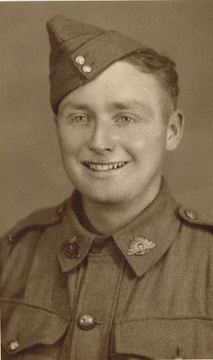MOUNTFORD, Sidney John
| Service Number: | SX7736 |
|---|---|
| Enlisted: | 3 July 1940, Adelaide, SA |
| Last Rank: | Corporal |
| Last Unit: | 2nd/48th Infantry Battalion |
| Born: | Canowie, South Australia, 30 July 1916 |
| Home Town: | Willowie, Mount Remarkable, South Australia |
| Schooling: | Not yet discovered |
| Occupation: | Blacksmith |
| Died: | Natural Causes, Penola, South Australia, 6 October 1996, aged 80 years |
| Cemetery: |
Penola (New) Cemetery Lawn C Section 15 |
| Memorials: | Penola Memorial Walk, Willowie WW2 Roll of Honour |
World War 2 Service
| 3 Jul 1940: | Involvement Corporal, SX7736 | |
|---|---|---|
| 3 Jul 1940: | Enlisted Adelaide, SA | |
| 3 Jul 1940: | Enlisted Australian Military Forces (WW2) , Corporal, SX7736, 2nd/48th Infantry Battalion | |
| 28 Sep 1945: | Discharged | |
| 28 Sep 1945: | Discharged Australian Military Forces (WW2) , Corporal, SX7736, 2nd/48th Infantry Battalion | |
| Date unknown: | Involvement 2nd/48th Infantry Battalion |
Help us honour Sidney John Mountford's service by contributing information, stories, and images so that they can be preserved for future generations.
Add my storyBiography contributed by Di Barrie
Sidney Jack Morgan Mountford was born 30 July 1916 at Canowie Station, South Australia, second son of Sidney Herbert and Ellen Elizabeth (nee Morgan) Mountford. Sidney Snr established a blacksmith shop at Willowie in January of 1923.
Jack (as he was known) listed his occupation as blacksmith when he enlisted 3 July 1940, at Recruit Reception Depot, Adelaide, aged 23 years. He was initially assigned to 2 Infantry Training Depot, but at that time the 2/48 Battalion (Btn) was being formed at Wayville Showgrounds. On 27 August 1940 Jack was marched out to join that unit. Conditions at Wayville were tough. The troops quarters were the motor pavilion, an unlined galvanised iron building. It was bleak, cold and draughty. Basic training began in earnest before Jack took pre-embarkation leave from the 15th to the 23rd of October.
On the 17 November 1940 Jack boarded the HMT ‘Stratheden’ to join the 9th Division in the Middle East. The 2/48 Btn was based at Dimra, and intensive training in desert warfare tactics ensued. 13 March 1941 the 2/48 Btn left Dimra heading west towards Benghazi, Libya. At the same time Rommel’s Afrika Corps were heading east towards them.
Early in the morning of 10 April the 9th Division began to fall back to the outer defences of the port town of Tobruk, Libya, as a result of the German led counter attack. The siege of Tobruk had begun. Under the command of General Leslie Morshead 31,000 men, mostly members of the 9th division, held the ‘fortress’ for the next eight months. It was on this day that Jack was wounded in action, sustaining a shrapnel wound to the scalp and evacuated to hospital. He was shipped to 2/1 Aust. Convalescent Depot at Kafr Vitkin (Palestine) to recover from his wound, after which he was posted to 26 Infantry Training Btn. He returned to his unit via the staging camp at Amiriya, Egypt, 2 June 1941.
Jack and the 2/48 Btn left Tobruk 22 October 1941, berthing at Alexandria and then moved to Julis, Palestine, where they remained for several months. 18 January 1942 the 2/48 Btn began its move to Syria for rest and garrison duties before moving to Egypt in June. In July of 1942 the Axis forces had reached El Alamein in Egypt. The 9th Division was rushed from Syria to the El Alamein area and held the northern sector for almost 4 months. On 4 October 1942, Jack was promoted to Acting Corporal.
23 October 1942 the 2nd battle of El Alamein commenced and the next day Jack was again wounded in action. He was evacuated to 2/3 Field Ambulance, returning to the 2/48 Btn on 28 October. The rank of Corporal was confirmed on 10 November 1942. On 1 January 1943 Jack left the Middle East aboard the “L4”, disembarking in Melbourne on 24 February. After some leave the 2/48 Btn moved to the Atherton Tablelands, Queensland, to undertake jungle training in preparation for service in New Guinea.
Jack embarked at Cairns aboard the USS ‘Henry T ‘Allen’, for Milne Bay, arriving on the 6 August 1943. He was admitted to 2/11 General Hospital on 29 September with Dengue fever. He returned to his unit at Buna on 18 October. The 2/48 Btn was based there, being the reserve battalion for the landing at Lae. They were subsequently heavily involved in the fighting towards Sattelberg and it can be assumed that Jack was with them at this time. He finally left New Guinea 7 February 1944, boarding the ‘Edward N Westcott’ at Finschaffen, disembarking at Brisbane thirteen days later. The unit was based at Ravenshoe in the Atherton Tablelands. Jack was evacuated to hospital with malaria, of which he suffered several relapses. In January 1945 he was posted to the Jungle Warfare Training Centre at Canungra as an instructor.
Jack was discharged from the army 28 September 1945. After the war he and his brother Bob operated a dairy in the Inman Valley near Victor Harbour. Jack married Mary Regina Menadue at the Salisbury Methodist Church on 16 November 1946. They had two children. After spending two years at Inman Valley Jack was offered a Soldier Settlement block 10 kms south of Penola, South Australia. In 1974 Jack and Mary shifted into Penola. Jack loved the land; however he was forced to retire with ill health twelve months before his death. He passed away 6 October 1996, at Penola, aged 80 years, and is interred at Penola Cemetery, Lawn C Section 15.











